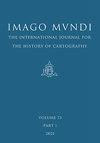The First Facsimile Collections and the Parisian Origins of the History of Cartography
IF 0.5
4区 历史学
Q4 GEOGRAPHY
Imago Mundi-The International Journal for the History of Cartography
Pub Date : 2023-08-22
DOI:10.1080/03085694.2023.2226951
引用次数: 0
Abstract
ABSTRACT Map historians have long thought that their field of study has an exceptional origin, springing into life fully-fledged in Paris in the 1840s when the Frenchman Edme-François Jomard and the Portuguese visconde de Santarém created large collections of facsimiles of medieval and Renaissance maps and then squabbled over credit for creating the ‘history of cartography’. This essay revises the story by adducing three earlier and much smaller collections by the Prussian Alexander von Humboldt, the Spaniard Ramón de la Sagra, and the French couple Xavier and Adèle Hommaire de Hell. The existence of these collections has hitherto been obscured by common bibliographical practices. This essay analyses the structure and design of all these facsimile collections and reads them in concert with their accompanying texts to reveal the emergence in Paris in the 1830s and 1840s of a scholarly concern for the comparative study of early maps. Together, these scholars wove existing threads of scholarship in the history of geography and discovery into a new field of study. The history of cartography thus possesses a communal and Western European rather than an idiosyncratic and national origin.第一批传真收藏和制图史的巴黎起源
本文章由计算机程序翻译,如有差异,请以英文原文为准。
求助全文
约1分钟内获得全文
求助全文
来源期刊
CiteScore
0.20
自引率
0.00%
发文量
32
期刊介绍:
The English-language, fully-refereed, journal Imago Mundi was founded in 1935 and is the only international, interdisciplinary and scholarly journal solely devoted to the study of early maps in all their aspects. Full-length articles, with abstracts in English, French, German and Spanish, deal with the history and interpretation of non-current maps and mapmaking in any part of the world. Shorter articles communicate significant new findings or new opinions. All articles are fully illustrated. Each volume also contains three reference sections that together provide an up-to-date summary of current developments and make Imago Mundi a vital journal of record as well as information and debate: Book Reviews; an extensive and authoritative Bibliography.

 求助内容:
求助内容: 应助结果提醒方式:
应助结果提醒方式:


